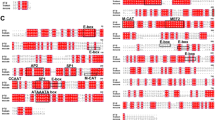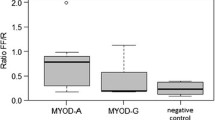Abstract
Myosin regulatory light chain (MLC) regulates myofilament activation via phosphorylation by Ca2+ dependant myosin light chain kinase. In order to further understand the functions of the porcine fast myosin regulatory light chain gene (HUMMLC2B) in muscle, the subcellular localization, the temporal and spatial distributions of its gene product were analyzed, and the association between the presence of specific polymorphisms and commercial meat traits in pig was also examined. HUMMLC2B was demonstrated to localize both in the cytoplasm and the nucleus by confocal fluorescence microscopy. Real-time PCR further revealed HUMMLC2B expression variation in a waveform manner in the skeletal muscle of both Chinese Tongcheng and Western Landrace pig breeds at days 33, 65 and 90 post coitum (pc). After birth, the expression levels of HUMMLC2B were also found to decrease gradually with age. Our spatial expression analysis showed that HUMMLC2B was highly expressed in the semitendinosus, gastrocnemius, biceps femoris and longissimus dorsi muscles. In contrast, only low levels of expression of this gene were evident in fat, and no expression was detectable in brain, heart, kidney, lung, liver, lymph node, spleen, stomach, or in either large or small intestine. A total of 23 potential polymorphisms, comprising 3 exonic and 20 intronic, were detectable in the porcine HUMMLC2B gene and the G1094A, T1513C, G1876A and T2005G polymorphisms were further analyzed. The significant associations between the T1513C, G1876A and T2005G polymorphisms with marbling score, dressing percent and meat color, respectively, were identified (P < 0.05). Associations with the percentage of leaf fat could also be demonstrated by analysis of haplotypes harboring these three polymorphisms. Our current results thus shed further light on the roles and functions of the HUMMLC2B gene in muscle.




Similar content being viewed by others
References
Aoki H, Sadoshima J, Izumo S (2000) Myosin light chain kinase mediates sarcomere organization during cardiac hypertrophy in vitro. Nat Med 6:183–188
Blumenthal DK, Stull JT (1980) Activation of skeletal muscle myosin light chain kinase by Ca2+ and calmodulin. Biochemistry 19:5608–5614
Bozzo C, Stevens L, Toniolo L, Mounier Y, Reggiani C (2003) Increased phosphorylation of myosin light chain associated with slow-to-fast transition in rat soleus. Am J Physiol Cell Physiol 285:C575–C583
Buckingham M, Bajard L, Chang T, Daubas P, Hadchouel J, Meilhac S, Montarras D, Rocancourt D, Relaix F (2003) The formation of skeletal muscle: from somite to limb. J Anat 202:59–68
Davoli R, Fontanesi L, Zambonelli P, Bigi D, Gellin J, Yerle M, Milc J, Braglia S, Cenci V, Cagnazzo M, Russo V (2002) Isolation of porcine expressed sequence tags for the construction of a first genomic transcript map of the skeletal muscle in pig. Anim Genet 33:3–18
Davoli R, Fontanesi L, Cagnazzo M, Scotti E, Buttazzoni L, Yerle M, Russo V (2003) Identification of SNPs, mapping and analysis of allele frequencies in two candidate genes for meat production traits: the porcine myosin heavy chain 2B (MYH4) and the skeletal muscle myosin regulatory light chain 2 (HUMMLC2B). Anim Genet 34:221–225
Delgado I, Huang X, Jones S, Zhang L, Hatcher R, Gao B, Zhang P (2003) Dynamic gene expression during the onset of myoblast differentiation in vitro. Genomics 82(2):109–121
Faerman A, Shani M (1993) The expression of the regulatory myosin light chain 2 gene during mouse embryogenesis. Development 118:919–929
Geldermann H, Müller E, Moser G, Reiner G, Bartenschlager H, Cepica S, Stratil A, Kuryl J, Moran C, Davoli R, Brunsch C (2003) Genome-wide linkage and QTL mapping in porcine F2 families generated from Pietrain, Meishan and Wild Boar crosses. J Anim Breed Genet 120:363–393
Harper SQ, Hauser MA, DelloRusso C, Duan D, Crawford RW, Phelps SF, Harper HA, Robinson AS, Engelhardt JF, Brooks SV, Chamberlain JS (2002) Modular flexibility of dystrophin: implications for gene therapy of Duchenne muscular dystrophy. Nat Med 8:253–261
Ju B, Chong SW, He J, Wang X, Xu Y, Wan H, Tong Y, Yan T, Korzh V, Gong Z (2003) Recapitulation of fast skeletal muscle development in zebrafish by transgenic expression of GFP under the mylz2 promoter. Dev Dyn 227:14–26
Katoh K, Kano Y, Amano M, Kaibuchi K, Fujiwara K (2001) Stress fiber organization regulated by MLCK and Rho-kinase in cultured human fibroblasts. Am J Physiol Cell Physiol 280:C1669–C1679
Kuninger D, Kuzmickas R, Peng B, Pintar JE, Rotwein P (2004) Gene discovery by microarray: identification of novel genes induced during growth factor-mediated muscle cell survival and differentiation. Genomics 84:876–889
Metzger JM, Moss RL (1992) Myosin light chain 2 modulates calcium-sensitive cross-bridge transitions in vertebrate skeletal muscle. Biophys J 63:460–468
Moran JL, Li YZ, Hill AA, Mounts WM, Miller CP (2002) Gene expression changes during mouse skeletal myoblast differentiation revealed by transcriptional profiling. Physiol Genomics 10:103–111
Moutou KA, Canario AVM, Mamuris Z, Power DM (2001) Molecular cloning and sequence of Sparus aurata skeletal myosin light chains expressed in white muscle: developmental expression and thyroid regulation. J Exp Biol 204:3009–3018
Nair R, Rost B (2005) Mimicking cellular sorting improves prediction of subcellular localization. J Mol Biol 348:85–100
Picard B, Lefaucheur L, Berri C, Duclos MJ (2002) Muscle fibre ontogenesis in farm animal species. Reprod Nutr Dev 42:415–431
Ridley AJ, Hall A (1992) The small GTP binding protein rho regulates the assembly of focal adhesion and actin stress fibers in response to growth factors. Cell 70:389–399
Russo V, Davoli R, Fontanesi L (2005) Genetic strategies to improve and control the quality of animal products. In: Proceedings of the XLIX Italian Society of Agricultural Genetics Annual Congress. Potenza, Italy, ISBN 88-900622-6-6
Sanjay S, Malay KR, Satyapriya S (2003) Human fast skeletal myosin light chain 2 cDNA: isolation, tissue specific expression of the single copy gene, comparative sequence analysis of isoforms and evolutionary relationships. DNA Seq 5:339–350
Schiaffino S, Reggiani C (1996) Molecular diversity of myofibrillar proteins: gene regulation and functional significance. Physiol Rev 76:371–423
Swatland HJ (1973) Muscle growth in the fetal and neonatal pig. J Anim Sci 37:536–545
Wang HL, Wang H, Zhu ZM, Yerle M, Wu X, Yang SL, Li K (2005) Radiation hybrid mapping of five genes isolated from a porcine fetus skeletal muscle cDNA library. Anim Genet 36:529–530
Xu YF, He JY, Tian HL, Chan CH, Liao J, Yan T, Lam TJ, Gong ZY (1999) Fast skeletal muscle-specific expression of a zebrafish myosin light chain 2 gene and characterization of its promoter by direct injection into skeletal muscle. DNA Cell Biol 18:85–95
Xu YF, He JY, Wang XK, Lim TM, Gong ZY (2000) Asynchronous activation of 10 muscle-specific protein (MSP) genes during zebrafish somitogenesis. Dev Dyn 219:201–215
Xu DQ, Xiong YZ, Ling XF, Lan J, Liu M, Deng CY, Jiang SW, Lei MG (2005) Identification of a differential gene HUMMLC2B between F1 hybrids Landrace × Yorkshire and their female parents Yorkshire. Gene 352:118–126
Zhu ZM, Zhang JB, Li K, Zhao SH (2005) Cloning, mapping and association study with carcass traits of the porcine SDHD gene. Anim Genet 36:191–195
Acknowledgments
The authors thank Prof Max F Rothschild of Iowa State University, USA, for revising the manuscript. This research was supported by the National 10th Five Year Scientific Project of China for Tackling the Key Problems (2004BA717B), National Natural Science Foundation of China (30571330), Key Project of National Natural Science Foundation of China (30330440), Key Project of Scientific Research Foundation of Ministry of Human Resources of China for Returned Chinese Scholars, the State Platform of Technology Infrastructure (2005DKA21101), National 973 and 863 projects of China.
Author information
Authors and Affiliations
Corresponding author
Additional information
Communicated by S. Hohmann
Rights and permissions
About this article
Cite this article
Wang, H.L., Wang, H., Zhu, Z.M. et al. Subcellular localization, expression patterns, SNPs and association analyses of the porcine HUMMLC2B gene. Mol Genet Genomics 276, 264–272 (2006). https://doi.org/10.1007/s00438-006-0142-8
Received:
Accepted:
Published:
Issue Date:
DOI: https://doi.org/10.1007/s00438-006-0142-8




